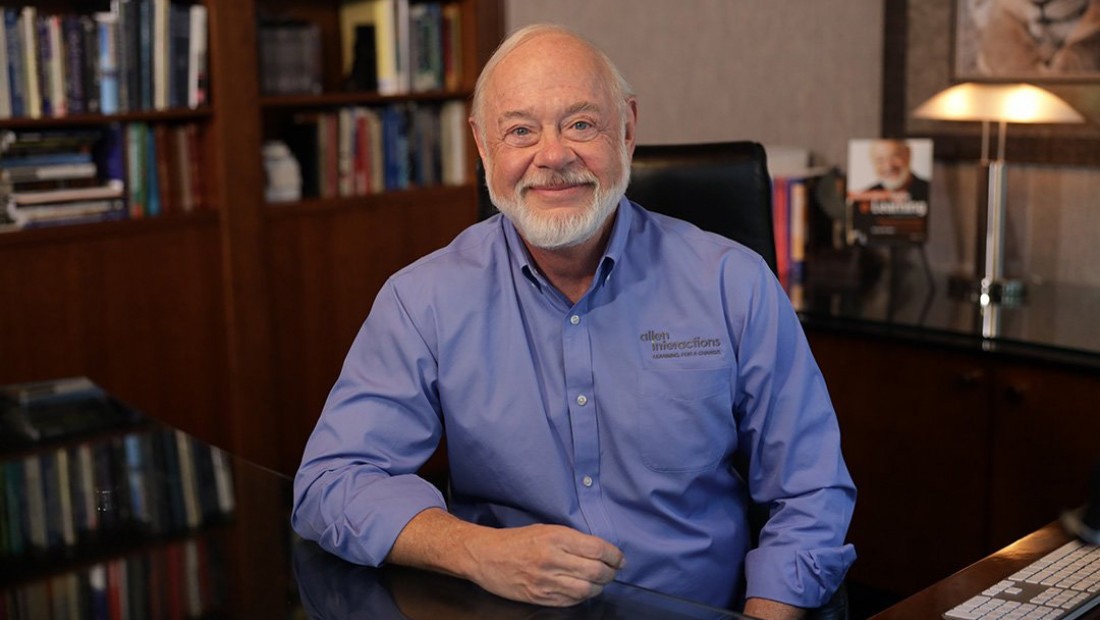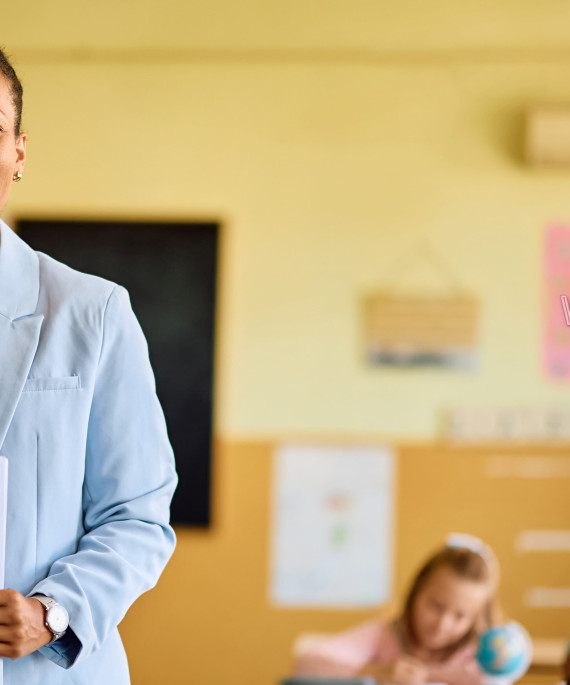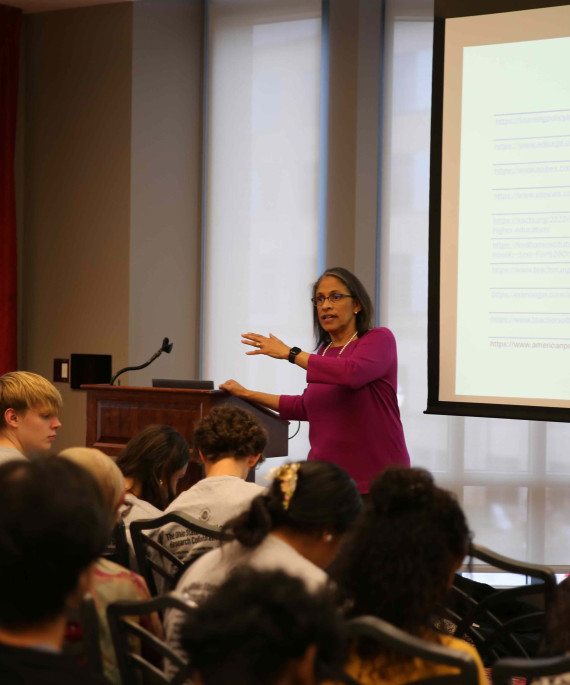Year of upheaval and innovation: 1968

Subscribe to Inspire
Apple Podcasts | Spotify | YouTube | Stitcher
Subscribe to the Inspire Podcast Newsletter
Transcript of Podcast
Robin Chenoweth: People who lived through both have drawn comparisons between 1968 and 2020. Like 2020, 1968 was a year of explosive social and political upheaval. Linden Johnson dropped out of the presidential race. In 60 days’ time, both Martin Luther King Jr. and Robert Kennedy were gunned down at the height of their influence. It was the peak of the Vietnam War, when 50 servicemen died daily. That summer, cities and towns erupted into flames. Demonstrators at the Democratic National Convention were clubbed and teargassed. The Hong Kong Flu, which would kill more than 30,000 Americans, came to U.S. soil that year. And that fall, Michael Allen for the first time stepped onto the campus of The Ohio State University to get his master’s degree in educational psychology. He would become an icon in the education technology realm, helping develop PLATO, the computer-based learning system, and founding Authorware — known to many by its later name, Macromedia. All the seeds for growing that knowledge were waiting in Columbus, Ohio, in 1968. He’d gotten his undergraduate degree at Cornell College, in Iowa.
Michael Allen: My advisor at Cornell said the leading person in the United States, if not the world, in the subject that you would like to teach is at Ohio State University. That's really where you should go. You should go study with the leading authority in the subject area that you want to go, and I think you should apply there. So I was very excited about going to Ohio State and studying human engineering which, you know, combined my interest in math, my interest in computers, my interest in psychology and hadn't yet woven education into it.
Robin Chenoweth: And then, 1968 struck.
Michael Allen: The saddest thing happened. And I had no knowledge of it until I arrived in Columbus, was at the university and ready to register.
Robin Chenoweth: Michael Allen was about to have the rug pulled out from under him. His plans disrupted. His expectations dashed. And … he was about to be given the opportunity to innovate in ways that no one at Ohio State ever had. This is Inspire, a production of Ohio State University’s College of Education and Human Ecology. I’m Robin Chenoweth. Carol Delgrosso is our audio engineer. The world’s leading expert in Human Engineering — the psychology of human beings interacting with machines — had in fact died three years before Michael Allen came to Ohio State University. Paul Fitts pioneered research while redesigning airplane controls for the military and had left for the University of Michigan some years before. He was 52 when he tragically succumbed to a stroke. But he left behind a renowned team at Ohio State … which by 1968 appeared to be fracturing. Michael Allen couldn’t have known this when he applied. Some researchers had followed Fitts to Michigan. One left suddenly — just before Allen arrived — for a position at Rice University. Fitts’ research partner, was switching his focus and didn’t want to take on the departing professor’s advisees. And to complicate matters, the Department of Psychology was breaking away from the College of Education. Michael Allen was adrift, without an advisor and without a clue what he was going to do.
Michael Allen: I was just kind of roaming the halls before school started. I was over in Arps Hall and trying to figure out how I could register for classes. I didn't know what classes I should take. And I just bumped into a professor, and he said, ‘I'll tell you what, let's just sit down and look at the course catalog. Let's pick a few courses and I’ll sign, so you can get registered. And then you can spend some time trying to find people that could advise you in directions that interest you,’ That's how I got started at Ohio State.
Robin Chenoweth: But it was 1968, which like 2020 was also a year of innovation, a year of switching course. And that’s exactly what Michael Allen did.
Michael Allen: It was kind of an open slate for me to fill in and educational psychology seemed like something that would appeal to me. And I found that it was possible for me to enroll in computer science courses as well, and engineering courses, and so I did.
Robin Chenoweth: Here’s the bit of inspiration that connected Michael Allen’s past with his 1968 present. Ohio State had just opened a state-of-the-art computer center on Neil Avenue, in the Systems Engineering Building, which was open for students to use for research and innovation. That center had next-level, on-fire technology. The IBM 360 Model 75 supercomputer.
Michael Allen: When, my friends, little kids in Clarion Iowa, were talking about what we were going to do in the future and my friends would say I'm going to be a cowboy, I'm going to be a policeman or fireman or something. I always said, I'm going to work for IBM. And they'd all kind of nod with a smile and not know what to say after that.
Robin Chenoweth: Prescient thinking for a kid in 1956. But in fact, Allen had turned down a job at IBM just out of Cornell College so that he might study computer-human interaction. And here at his disposal was the hottest technology of all. In 1968, Michael Allen had an eye cast toward what would happen in 1977, when personal computers were introduced, and 1990 — when the world wide web was launched — and especially in 2020, when online learning would become an indispensable part of educating people.
Michael Allen: I realized that computers were going to enter into the education arena. Whether we liked it or not, obviously. And I thought, ‘We need people who care about education, directing the development of technology, rather than people who are just fans of technology and wanting to stick it out wherever it might be accepted. And so this really led me on an adventure that was just fantastic.
Robin Chenoweth: He hit the ground running. He had zero computing experience. But he started tinkering around at the demonstration centers.
Michael Allen: I found all these manuals on programming, and I just asked students around, you know, ‘How do you do this? How do you do that?’ And I started writing programs. And then one of the professors in psychology had done some studies, and he had a lot of data, a lot of data, and he had it on magnetic tape, but he didn't know how to do any analysis and he needed some correlation analysis, analysis variance and so forth. he said, ‘Could you do that, could you do.. of course,’ I said. ‘Sure, I can.’
Robin Chenoweth: The professor even offered to cover Allen’s tuition and pay him a stipend.
Michael Allen: Oh my gosh. The best thing ever. And so that's what happened. I analyzed this data, got familiar with all the people at the computer centers, and then started exploring how to use computers in education. And at IBM demonstration center they said, ‘This is a future market for us. If you want to do that kind of work, we’d like to work with you and, and let's just team up.’ Doors were opening right and left for me at OSU. It was an unbelievable experience.
Robin Chenoweth: It might be helpful to those who were toddlers in 1968, or who’ve never dialed a landline phone, to get a snapshot of the technology landscape of that era. Personal computers were still a decade in the future. The room-sized supercomputers first employed during World War II, and which had sent John Glenn into orbit a few years before, weren’t just being used by the military. The B in IBM, remember, stands for business. Those systems used punch cards and magnetic tape to enter data. And colleges and universities with their massive data sets were starting to rely on them more and more.
Michael Allen: They were being increasingly used in industry for a variety of special purposes and almost all colleges and universities quickly went to using computers for scheduling courses and scheduling students and then billing and issuing grades and so forth. But scientists, which were housed primarily at universities, needed that power to analyze their data.
Robin Chenoweth: Though they weren’t calling it educational technology yet, its seeds were beginning to take root. This is where students in modern America will want to take note. Because in the late 1960s the university had landed a National Science Foundation grant to examine how students adapted to self-guided, learning. An experiment conducted on West Campus was the antecedent of online learning today. The revamped biology 101 had no in-person classes, no quizzes or midterms. Instead, students went to the lab, and picked up a numerical tab.
Michael Allen: That would be the number of a study carol that was available, and you walk in and dump your books and stuff on a little desk, and there was a telephone in it, and a list of recordings, and you would dial a number of the recording that you'd want to hear, and a professor would have recorded a lecture on that topic.
Robin Chenoweth: A giant video player with a tiny TV screen could be wheeled to the cubicle. Fruit flies and plants and mice were available for experiments.
Michael Allen: Which made bio 101 potentially very, very exciting. The flipside was that it was not a success. It was not a success for several reasons, one of which was that students weren't used to monitoring and disciplining themselves in the learning path, you know, up to that point. I think everybody could easily imagine what did indeed happen.
Robin Chenoweth: We know it, because we still see this happening today. Without the extrinsic motivation of classes and professors and deadlines, most students didn’t show up at all — until the last two weeks of the term.
Michael Allen: In those last two weeks. Students complained because the center closed at 2 a.m. for cleaning and didn't reopen again until five, five in the morning, cuz ‘we have to study, you can't close. We have to study. The exam is coming up.’
Robin Chenoweth: When those students were tested weeks after their final exam, they had forgotten nearly ALL of the material. Allen knew that, done correctly, self-guided learning — using computers — could have been so much better.
Michael Allen: My professors who were suggesting I go my own way, said, ‘Why don't you do something about this? You’re an educational psychologist-to-be. What ideas do you have?’
Robin Chenoweth: They suggested he apply for another grant.
Michael Allen: And so I did. And I got funded. And that launched my career anyway in educational technology because I did in fact, move computer terminals into the bio Learning Center and design some programs that turned out to be pretty instructive about different ways we can use computers in education.
Robin Chenoweth: As Vietnam protests surged on campus, Michael Allen worked as a teaching assistant, walking to classes while the national guard carried bayonets across the Oval. And he began to study how students learned and how they COULD learn from computers.
Michael Allen: One of the potential opportunities that computers provide is that they can do different things for each student, they can respond to you as an individual.
Robin Chenoweth: He delved into how. Do some want to be challenged? Do some want to be led? Do some learn best by reading, and others by listening to instruction? What answers might students give to a question, and then, how could a computer respond in a very specific way that propelled their learning? There were no good programming languages for e-learning. So Allen began writing them. It formed the backbone of his Computer Assisted Instruction, which fully incorporated the educational psychology he was becoming so immersed in. This all happened years before the release of the Apple computer. Before floppy disks and CDs and well before the internet.
Michael Allen: And everything that we did was very carefully thought through and discussed, primarily because it was so expensive to do. Every minute that we use the computer was a cost, and the development languages took a fair amount of effort to develop everything that we did. And there weren’t good precedents. We were cutting new paths in the use of technology in education, so we had to do a lot of imagining of what might be the best thing to do, and then ask the question, is that possible? Can the technology do it? And so the things that came out of that work tended to be of very high educational quality and impact. There weren’t arbitrary things done because we couldn't afford to just do things really on a whim.
Robin Chenoweth: He did it so well that the university hired him straight away after he received his doctorate, to lead a computer assisted learning project. And then, Controlled Data Corporation in Minneapolis hired him to help steer research and development for PLATO, the upcoming computer learning system.
Michael Allen: Our whole purpose was trying to find a better way of teaching than face to face. And that's a pretty big challenge doing something better than face to face because that's, that's worked for a long time. And, good instructors are insightful, inspiring, nurturing and just treasures. Absolutely. And we wanted to do something even better than that. We wanted to take those characteristics and somehow deliver them digitally and provide every student an experience that's adapted to them; it's just for them. So we were taking on a lot and trying to do really good stuff.
Robin Chenoweth: He was determined to take the yawn-factor out of computer-based learning.
Michael Allen: I was working on the Plato system, but I was realizing that a lot of the instructional material that people were developing was pretty boring. I was not for the proliferation of boring. Really, I wanted it to be fantastic, you know, game-like learning, simulation-based learning. Smart learning that responds to individuals.
Robin Chenoweth: And he wanted to make the system accessible to teachers. And so he simplified, allowing teachers to draw flowcharts on touch panels as the computer did the coding for them. He tested the program on a group of nuns who were teachers from St. Paul.
Michael Allen: I asked them to try to use this tool that I developed that was kind of a non-programming, programming system, if you will. And they did great stuff. I was just blown away. And they kept saying, ‘This is so fun because we don't even have to wad up a lot of paper and fill up a wastebasket when we change our minds. We can just point to things and drag them and put them in a different place,’.
Robin Chenoweth: But something was on the horizon that could disrupt his work. The personal computer.
Michael Allen: We were using those supercomputers, and we were using telephone lines for connections, and we were using terminals that cost $10,000 and more. And so it was way too expensive for individuals and even colleges and universities to use on a production basis, it was just only paving the way.
Robin Chenoweth: When Allen and a few colleagues broke away to form their own company in 1983, Steve Jobs had just introduced Lisa, the personal computer whose architecture was a miniature of the mainframe systems they had used. His team approached Apple with their work.
Michael Allen: They said, ‘We didn't think this was possible with our, our systems. What do you need?’ I said, ‘I need some money. And I need some computers. I need some printers,’ They just came out with a laser printer. And less than two weeks later on my doorstep were all these the boxes.... And the message was, we will give you some funding, and the only strings attached to it are that if you don't take this technology you're developing to market on your own, then we get to do it, because it's got to get out there. That started my relationship with Apple, and we built our first systems on Apple computers. And that was Authorware. And in a few short years, why, we had the predominant market in educational technology.
Robin Chenoweth: Here’s another technology timeline snapshot. When he started his Authorware work, personal computers had limited audio capabilities. Graphic capabilities, though developing rapidly, were still limited. Everything was monochromatic.
Michael Allen: The mouse was a brand-new thing, and pretty wonderful, but we were building systems before that, with just the keyboard. And all in a fairly rapid succession, we got the integration of all of these things. So we could play audio. We could show photographs. We could draw with vector graphics, very precise illustrations and diagrams. So presentation capabilities got great.
Robin Chenoweth: Dissemination of programs was a bear, though, because they were enormous data hogs that computers just couldn’t handle.
Michael Allen: You had to use them very wisely and very very sparingly because, otherwise, it was only going to reside on your computer nobody else can have it, because the networking was not there, was not capable. And then came along the floppy disks, and then we got higher density floppy disk, but then we had DVDs that could store so much more data and that just opened up everything so now we could distribute it. It now became much more practical to have more engaging learning experiences going on. And then we got the Internet.
Robin Chenoweth: 1993. The year the internet became available to average people, changed everything.
Michael Allen: And you would think for sure for the better. It wasn't for the better at first, and there are still echoes of some damage that that that did, and that's the most surprising thing ever.
Robin Chenoweth: Be careful what you wish for.
Michael Allen: I grew up with both the IBM System at OSU and the PLATO system at CDC and University of Illinois, as being online, we now call them cloud-based systems so that any change you made was distributed immediately. But we lost that as we went to personal computing, and then the internet popped up and we're thinking, ‘Oh, this is fantastic. It’s bringing us back,’. We got better media integration, better data analytics and truly everything we wanted…. really everything we wanted.
Michael Allen: What happened is the quality of digital learning sank. Instead of getting better, as you would expect, It went down. And why did it go down? Well, my theory on this is that when we were using the more primitive systems and the more expensive systems, we had to be deliberate and everything we did. So we really had to think carefully. Is this thing I'm doing going to benefit a student? When we're in education, we're stewards of people's time, and we need to be very conscientious about the use of it. And so some of the most spectacular learning programs that have ever been built were built back in those times before the internet and they were just extraordinary. Just extraordinary. They stand as models today. When things got cheaper and distribution was so easy, people jumped on it for education and training, primarily because it was cheaper, not because it was better anymore, which was our whole purpose was trying to find a better way of teaching them face to face.
Robin Chenoweth: Professional trainings, MOOCS, online classes and all the webinars anyone could ever imagine became available. And nearly all of them lacked that critical knowledge in which Michael Allen had come to know so well at Ohio State. How do people learn? How are students different? How can you capture those differences and use them to make online learning pertinent, relevant, motivational and fun? All of those keys are found in educational psychology, and with few exceptions still aren’t being applied to online training and learning today.
Michael Allen: The preponderance of what I see being done focuses on delivery of content. It's just shoveling information out in appealing ways. It's done, often with beautiful graphics and nice navigation and some interactivity in the sense that you roll over things when they pop up and that can be amusing for a while. That novelty wears off pretty quickly as we all know we rapidly go off to something else. But what people are doing wrong is they're focusing on getting that information correct, logically organized, beautifully organized and expect somehow that exposing people to content is equivalent to a learning experience. And that's just not the case. We can do amazing things with this technology, but it's all been watered down, just so terribly by the tools and the technology that are available to everyone, whether you know what you're doing or not.
Robin Chenoweth: And so, after selling Authorware — which became Macromedia — to Adobe Systems, and then being terribly disappointed in what emerged, Michael Allen went back to work. He’s written eight books, spoken at a multitude of conferences. He runs a company that endeavors to make online learning count, changing e-learning in a way that the world badly needs in 2020. A few years ago, he and several friends issued a serious e-learning manifesto. Signers-on pledged to make online learning performance focused, meaningful to its learners and engagement driven. Part of that means creating far more material than any one learner will see, because good e-learning responds to the questions or actions that individual learners might present.
Michael Allen: Serious e-learning asks you to do things, almost from the very beginning. So, here's the task. Take a run at it, see how you can do, and we will work with you to perfect your skills.
Robin Chenoweth: The best e-learning is not passive. It’s active. That’s something psychologists have known for a long time.
Michael Allen: What we need to do is to focus on the learner’s journey. How are you feeling about this content when you start? Do you have good levels of competencies already that you're coming into, or is this entirely foreign to you? Because with well-designed software, we can recognize all those differences, and we can adapt to them so that every minute of learner’s time is used effectively.
Robin Chenoweth: So you can personalize the learning to the learner, and that's one advantage of doing it this way.
Michael Allen: I think it's one of the most important things. We would do that ideally face to face as we could. So, I often think of mentorship as the best of all worlds. If you've had somebody who was a caring, expert mentor to sit with you to work with you, we’d all opt for that. So why not use that as the model for what we aspire to do with the technology? And we can do a fair amount of it. And I think as artificial intelligence grows, our mentoring capabilities are going to grow by leaps and bounds. So in the future I think is very bright and very attractive in this field.
Robin Chenoweth: And as far as the strife and dissonance and polarization that we see in 2020 and he saw in 1968, Michael Allen envisions a very feasible solution. He is first a psychologist but always an educator. I asked him about the goal of world peace he lays out in his book.
Robin Chenoweth: Were you joking when you said that one objective of yours was world peace?
Michael Allen: No.
Robin Chenoweth: No, really?
Michael Allen: Yeah.
Robin Chenoweth: It seems really ambitious but I'm curious as to how you hope to contribute to that.
Michael Allen: I believe a lot of the discord that we have in the world is because we have such different education; we have such different backgrounds. So, it's hard for us to understand each other, even when we try very hard to communicate. In our country, I hear, pretty much daily arguments that are taking the same information and concluding different things. They’re taking some aspect of the data and extrapolating on it in incorrect ways. If you think you understand someone and then extrapolate from that, and your understanding is wrong, you ascribe very incorrect intentions and principles to what they're saying. And so you end up in the argument that should never have been an argument in the first place. So, I think if we all had more fundamentally similar roots, in a way, and again I'm not saying we give up our culture. But if we just have knowledge of what others know, and think, and have been through, then I think many of the points of discord and friction will cease. So I do think education is perhaps the most potent path to peace in the world. And I don't mean it as a joke.




